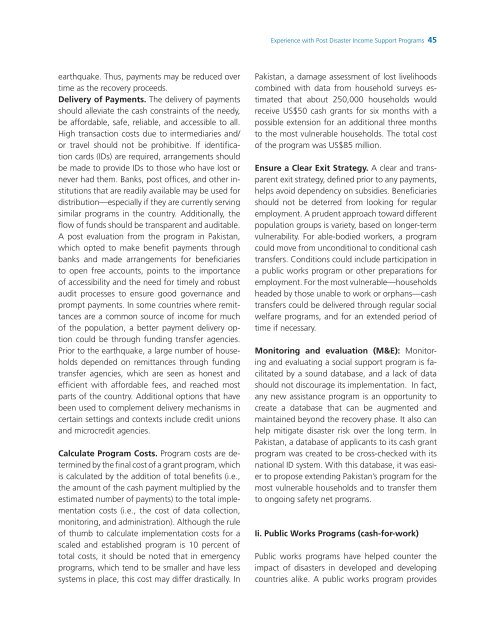Haiti Earthquake Reconstruction Knowledge Notes from ... - GFDRR
Haiti Earthquake Reconstruction Knowledge Notes from ... - GFDRR
Haiti Earthquake Reconstruction Knowledge Notes from ... - GFDRR
Create successful ePaper yourself
Turn your PDF publications into a flip-book with our unique Google optimized e-Paper software.
Experience with Post Disaster Income Support Programs 45<br />
earthquake. Thus, payments may be reduced over<br />
time as the recovery proceeds.<br />
Delivery of Payments. The delivery of payments<br />
should alleviate the cash constraints of the needy,<br />
be affordable, safe, reliable, and accessible to all.<br />
High transaction costs due to intermediaries and/<br />
or travel should not be prohibitive. If identification<br />
cards (IDs) are required, arrangements should<br />
be made to provide IDs to those who have lost or<br />
never had them. Banks, post offices, and other institutions<br />
that are readily available may be used for<br />
distribution—especially if they are currently serving<br />
similar programs in the country. Additionally, the<br />
flow of funds should be transparent and auditable.<br />
A post evaluation <strong>from</strong> the program in Pakistan,<br />
which opted to make benefit payments through<br />
banks and made arrangements for beneficiaries<br />
to open free accounts, points to the importance<br />
of accessibility and the need for timely and robust<br />
audit processes to ensure good governance and<br />
prompt payments. In some countries where remittances<br />
are a common source of income for much<br />
of the population, a better payment delivery option<br />
could be through funding transfer agencies.<br />
Prior to the earthquake, a large number of households<br />
depended on remittances through funding<br />
transfer agencies, which are seen as honest and<br />
efficient with affordable fees, and reached most<br />
parts of the country. Additional options that have<br />
been used to complement delivery mechanisms in<br />
certain settings and contexts include credit unions<br />
and microcredit agencies.<br />
Calculate Program Costs. Program costs are determined<br />
by the final cost of a grant program, which<br />
is calculated by the addition of total benefits (i.e.,<br />
the amount of the cash payment multiplied by the<br />
estimated number of payments) to the total implementation<br />
costs (i.e., the cost of data collection,<br />
monitoring, and administration). Although the rule<br />
of thumb to calculate implementation costs for a<br />
scaled and established program is 10 percent of<br />
total costs, it should be noted that in emergency<br />
programs, which tend to be smaller and have less<br />
systems in place, this cost may differ drastically. In<br />
Pakistan, a damage assessment of lost livelihoods<br />
combined with data <strong>from</strong> household surveys estimated<br />
that about 250,000 households would<br />
receive US$50 cash grants for six months with a<br />
possible extension for an additional three months<br />
to the most vulnerable households. The total cost<br />
of the program was US$85 million.<br />
Ensure a Clear Exit Strategy. A clear and transparent<br />
exit strategy, defined prior to any payments,<br />
helps avoid dependency on subsidies. Beneficiaries<br />
should not be deterred <strong>from</strong> looking for regular<br />
employment. A prudent approach toward different<br />
population groups is variety, based on longer-term<br />
vulnerability. For able-bodied workers, a program<br />
could move <strong>from</strong> unconditional to conditional cash<br />
transfers. Conditions could include participation in<br />
a public works program or other preparations for<br />
employment. For the most vulnerable—households<br />
headed by those unable to work or orphans—cash<br />
transfers could be delivered through regular social<br />
welfare programs, and for an extended period of<br />
time if necessary.<br />
Monitoring and evaluation (M&E): Monitoring<br />
and evaluating a social support program is facilitated<br />
by a sound database, and a lack of data<br />
should not discourage its implementation. In fact,<br />
any new assistance program is an opportunity to<br />
create a database that can be augmented and<br />
maintained beyond the recovery phase. It also can<br />
help mitigate disaster risk over the long term. In<br />
Pakistan, a database of applicants to its cash grant<br />
program was created to be cross-checked with its<br />
national ID system. With this database, it was easier<br />
to propose extending Pakistan’s program for the<br />
most vulnerable households and to transfer them<br />
to ongoing safety net programs.<br />
Ii. Public Works Programs (cash-for-work)<br />
Public works programs have helped counter the<br />
impact of disasters in developed and developing<br />
countries alike. A public works program provides

















